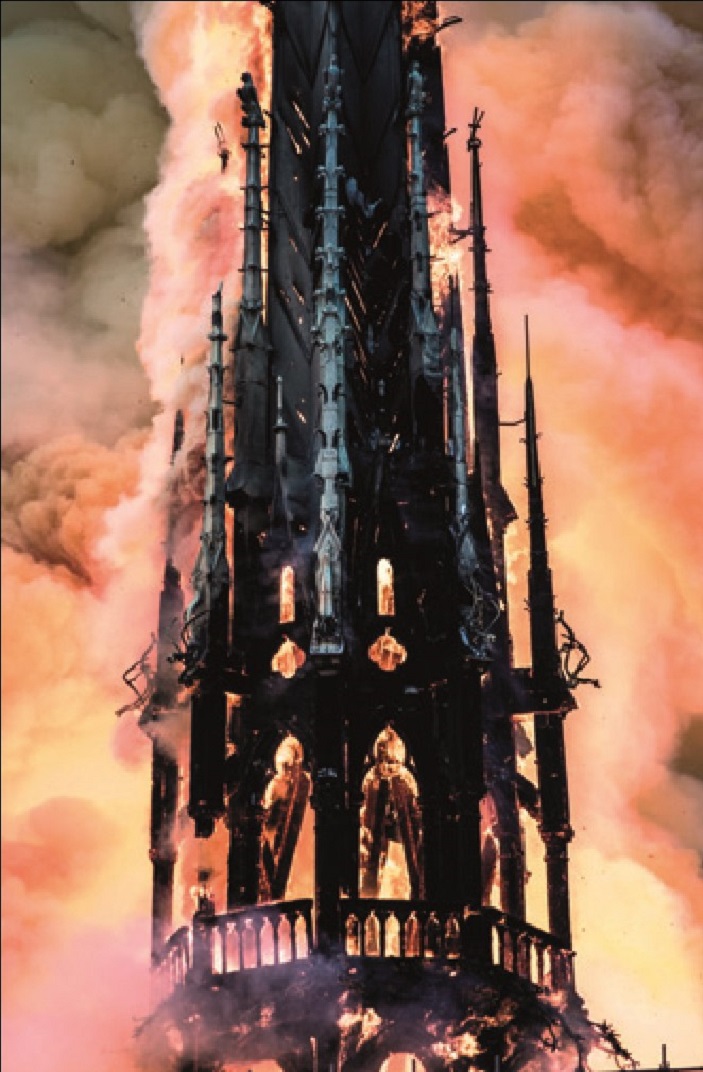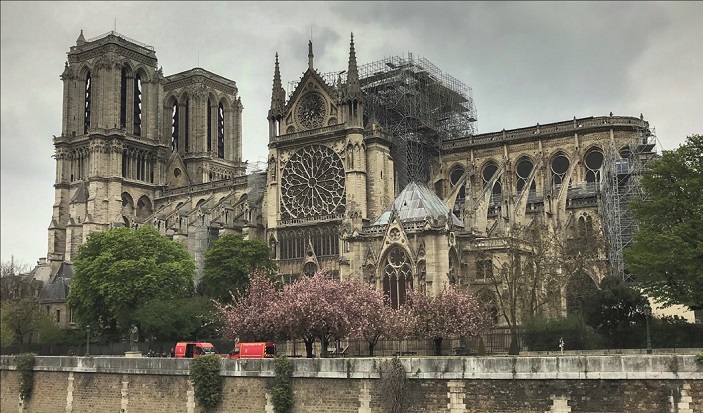Notre Dame
The Need for Better Fire Prevention Strategies
Jonathan Taylor and Felicity Fox
 |
||
| By the time Parisian firefighters arrived to tackle the fire at Notre Dame cathedral it had already taken hold and the medieval wooden roof couldn’t be saved. This could have been prevented or contained using compartmentation or sprinkler systems. (Photo: Manhhai, CC BY 2.0, http://bc-url.com/fire) |
The last decade has seen the destruction of a number of historic buildings as a result of preventable fires, including most recently, the cathedral of Notre Dame in Paris, which suffered serious damage to its roof and the collapse of its spire in April 2019. Thankfully, the Gothic cathedral’s main structure, its magnificent rose windows and much of its original fabric was saved largely due to the efforts of the 400 firefighters deployed, and there was no loss of life. However, at roof level the destruction was almost complete, including the craftsmanship and creativity dating back to the 12th and 13th centuries.
The global media attention which followed the fire highlights the value placed on our historic churches and cathedrals by the public. The TV images of the people of Paris standing in stunned silence is evidence of how deeply these buildings are ingrained in our cultural identity. And the impact was not limited to Parisians alone. Coverage in the UK was unprecedented, dominating the headlines for days, and the tragedy was widely reported across the world.
Key factors behind the significance of this landmark building to ordinary people include the clearly visible layering of history in its architecture and fabric; the decorative detailing of carved timber and stonework; its imagery of fantastical beasts and demons; and its scale as well as the unique quality of its interior with its dappled light, filtered by leaded light windows and stained glass. These qualities are shared with countless medieval churches throughout the UK and Europe, and while Notre Dame may have the additional fame which comes from its location in a capital city and its depiction in popular fiction, it is a mistake to think of cathedrals, churches, mosques and synagogues as being simply religious buildings belonging to a group of a particular faith. This was recognised in French president Emmanuel Macron’s immediate announcement that the state would step in to ensure the building is restored to its former glory. But the tragedy and its popular perception also highlights the need for state involvement at a much earlier stage, in the maintenance and repair of historic places of worship too, to minimise the risk of such losses in the future.
MANAGING THE RISKS
 |
||
| Much of Notre Dame’s interior was damaged during the fire, but the three great rose windows (pictured before the fire took hold) remain intact (Photo: Alvesgaspar – Own work, CC BY-SA 4.0, http://bc-url.com/rose-window) |
Historic buildings are particularly vulnerable to fire damage for many reasons. Often due to fear of causing irreversible harm to the historic fabric, respective owners and managers are reluctant to retrofit their buildings effectively. This could include the installation of fire suppression systems such as water sprinklers which can help to extinguish a fire at the point of ignition, and fire compartmentation (fire barriers incorporating floors, walls and doors) which can prevent a fire from spreading to other parts of the building. Electrical installations and appliances may be old and inadequate for the current use of the building and vulnerable to overheating. Alarm systems which should alert the first responders to a blaze in its infancy are often inadequate due to their age or poor design, and often the water supply on site is inadequate to fight a fire.
What’s more, in very old buildings there is often an accumulation of combustible debris in floor voids and roof spaces where it is surrounded by structural timbers and boards. Once ignited, the flames spread quickly and are difficult to extinguish.
Time is of the essence when containing a blaze and, as such, organisations like Historic England strongly recommend that an emergency contingency plan be in place to help staff and firefighters mitigate risk to life, rescue any important artefacts, and to understand the layout of the building to maximise efficiency in a crisis. However, for too many historic buildings and their owners this isn’t a priority and by the time disaster strikes it is too late.
WHY NOTRE DAME CAUGHT FIRE
The exact cause of the fire at Notre Dame has yet to be determined and an investigation is ongoing, but at the time, renovations were being undertaken to the cathedral’s central spire. Construction sites can create a hazardous environment in terms of fire safety for many reasons: an increased number of electrical and ignition sources through the use of temporary power supplies and hot works such as the heating of lead; doors being propped open while works are under way, potentially interfering with fire separation systems; disabling alarms to avoid falsely triggering them with dust; and smoking on site, to name a few.
One of the theories that has been circulating in reports since the incident suggests that the fire was started by an electrical short-circuit. Some sources have speculated that this could be related to the electrified bells in the cathedral beneath the spire and in the dry timber beamed attic known as the ‘forest’.
At this stage in the investigation the accuracy of this, and any other theory on the fire’s origin, can’t be confirmed, but we do know that once the building’s roof caught fire, it continued to burn. Notre Dame’s roof was a massive timber structure in an enclosed and extremely dry environment, making it highly susceptible to fire and causing it to take hold very quickly. This, in conjunction with the fire’s roof-top location and the inability to drop water from the air for fear of causing further damage to the building’s structure, made it particularly challenging for firefighters to tackle on their arrival.
 |
||
| The cathedral’s spire was completely destroyed as a result of the fire (Photo: LEVRIER Guillaume - Own work, CC BY-SA 4.0, http://bc-url.com/spire) |
Interestingly, Notre Dame did have a fire alarm system in place but clearly it is not fit for purpose. It has emerged in a number of news reports that the alarm was not equipped to notify emergency responders immediately when a fire was detected. Instead it was left up to a guard to investigate the cause of the alarm before contacting the authorities. It has also been reported that the fire was mistakenly thought to have started in another part of the cathedral, before it was discovered in the attic after the alarm sounded a second time. Both of these factors resulted in a delay significant enough to allow the fire to become fully established and to spread before the first responders arrived on the scene.
If a sprinkler system had been installed the fire could have been extinguished before there was any need to involve the fire service, and had fire barriers been installed in the roof space it is likely that the fire could have been contained, limiting the damage. But officials had decided not to retrofit Notre Dame with a sprinkler system or fire walls because ‘they were concerned electrical wiring would be too big a risk to the timber’, as reported by The New York Times.
Of course, they may also have been concerned that retrofitting fire barriers in Notre Dame’s roof voids and attic would risk disfiguring the building’s original structure and fabric, preventing the appreciation of the ‘forest’. Certainly this is a factor that has to be considered, and it is all too easy with the benefit of hindsight to see the balance of issues falling in favour of one particular conclusion. What’s important is that future decisions affecting historic buildings are better informed. Is it better to compromise a building’s original fabric to protect its overall structure and heritage from complete destruction, or to run the risk?
RECONSTRUCTION
Soon after the fire was extinguished, President Macron pledged that Notre Dame will be repaired and rebuilt in five years. He launched an international funding campaign to help make this happen, which has since raised hundreds of millions of pounds in donations from individuals and organisations including L’Oreal and luxury goods conglomerate LVMH.
Although the president favoured incorporating new design in the reconstruction, the French Senate subsequently passed a bill requiring that the reconstruction be faithful to the ‘last known visual state’ of the building, including Viollet-leDuc’s spire, and that any use of new materials will need to be justified.
It is perhaps needless to say that five years is a worryingly short time to undertake a sensitive and well-informed conservation project on such a large scale. The archaeological investigation and recording of all the debris in the building survey could take a substantial portion of this time, and until the investigation phase is completed it will not be clear how much of the masonry structure will need to be rebuilt. Often during such projects structural and technical issues can reveal themselves as works progress, causing unforeseen delays and complications and raising the cost of the project and the length of time needed for completion.
Another factor to be considered is the shortage of specialists available with the appropriate expertise needed to work on repairing, reconstructing and conserving historic buildings like Notre Dame. No doubt experts from the UK and around the world will be brought in to assist.
SALUTARY LESSONS
 |
||
| The fire at Notre Dame Cathedral (pictured after the fire was extinguished) underlines the importance of protecting our historic buildings from disaster by installing fire protection systems and having emergency planning procedures in place. (Photo: Louis HG - Own work, CC BY-SA 4.0, http://bc-url.com/notre-dame) |
At a time when fewer people are attending church services, it is important that we learn from this tragedy that we must maintain and properly manage historic places of worship. In the UK our rich legacy of historic churches and cathedrals must be better recognised as jewels in our cultural landscape, and their protection and conservation cannot be left to their congregations and worshippers alone.
Although fire captures the imagination far better than the slow deterioration and decay of historic buildings, the result is the same, and both funding and skills to help manage and prevent this are in short supply.
Further Reading
For more on the importance of emergency planning in historic buildings, see Simon Kincaid’s article at BuildingConservation.com
Amaud Siad, ‘There are no trees in France that are big enough to rebuild Notre Dame’s roof’, CNN World, 2019, https:// cnn.it/2Msne38
Ashley Collman, ‘Notre Dame officials chose not to install fire safety upgrades that could have limited the devastating blaze’, Business Insider, 2019, http://bcurl.com/fire-safety-upgrade
Fire Protection Association, ‘The Fire Protection Association statement on the fire at Notre Dame cathedral’ 2019, http:// bc-url.com/fire-protection-association
Frances Perraudin, ‘Notre Dame: How to save an iconic building from a fire’, The Guardian, 2019, http://bc-url.com/ notre-dame-restoration
Historic England, ‘Writing an Emergency Response Plan’, 2019, http://bc-url.com/ fire-response-plan
Katrin Bennhold and James Glanz, ‘Notre Dame’s safety planners underestimated the risk, with devastating results’, The New York Times, 2019, https://nyti.ms/2XzxeZt



